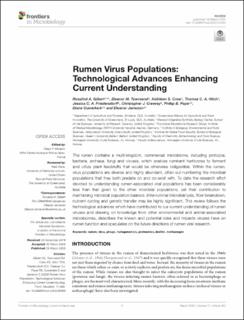| dc.contributor.author | Gilbert, Rosalind A. | |
| dc.contributor.author | Townsend, Eleanor M. | |
| dc.contributor.author | Crew, Kathleen S. | |
| dc.contributor.author | Hitch, Thomas C.A. | |
| dc.contributor.author | Friedersdorff, Jessica C.A. | |
| dc.contributor.author | Creevey, Christopher J. | |
| dc.contributor.author | Pope, Phillip Byron | |
| dc.contributor.author | Ouwerkerk, Diane | |
| dc.contributor.author | Jameson, Eleanor | |
| dc.date.accessioned | 2020-11-11T11:10:25Z | |
| dc.date.available | 2020-11-11T11:10:25Z | |
| dc.date.created | 2020-05-07T15:25:43Z | |
| dc.date.issued | 2020 | |
| dc.identifier.citation | Frontiers in Microbiology. 2020, 11:450 1-26. | en_US |
| dc.identifier.issn | 1664-302X | |
| dc.identifier.uri | https://hdl.handle.net/11250/2687351 | |
| dc.description.abstract | The rumen contains a multi-kingdom, commensal microbiome, including protozoa, bacteria, archaea, fungi and viruses, which enables ruminant herbivores to ferment and utilize plant feedstuffs that would be otherwise indigestible. Within the rumen, virus populations are diverse and highly abundant, often out-numbering the microbial populations that they both predate on and co-exist with. To date the research effort devoted to understanding rumen-associated viral populations has been considerably less than that given to the other microbial populations, yet their contribution to maintaining microbial population balance, intra-ruminal microbial lysis, fiber breakdown, nutrient cycling and genetic transfer may be highly significant. This review follows the technological advances which have contributed to our current understanding of rumen viruses and drawing on knowledge from other environmental and animal-associated microbiomes, describes the known and potential roles and impacts viruses have on rumen function and speculates on the future directions of rumen viral research. | en_US |
| dc.language.iso | eng | en_US |
| dc.rights | Attribution-NonCommercial-NoDerivatives 4.0 Internasjonal | * |
| dc.rights.uri | http://creativecommons.org/licenses/by-nc-nd/4.0/deed.no | * |
| dc.title | Rumen virus populations: Technological advances enhancing current understanding | en_US |
| dc.type | Peer reviewed | en_US |
| dc.type | Journal article | en_US |
| dc.description.version | publishedVersion | en_US |
| dc.source.pagenumber | 1-26 | en_US |
| dc.source.volume | 11 | en_US |
| dc.source.journal | Frontiers in Microbiology | en_US |
| dc.identifier.doi | 10.3389/fmicb.2020.00450 | |
| dc.identifier.cristin | 1809836 | |
| dc.relation.project | EC/FP7/ERC-336355 | en_US |
| dc.relation.project | Norges forskningsråd: 250479 | en_US |
| dc.source.articlenumber | 450 | en_US |
| cristin.ispublished | true | |
| cristin.fulltext | original | |
| cristin.qualitycode | 2 | |

